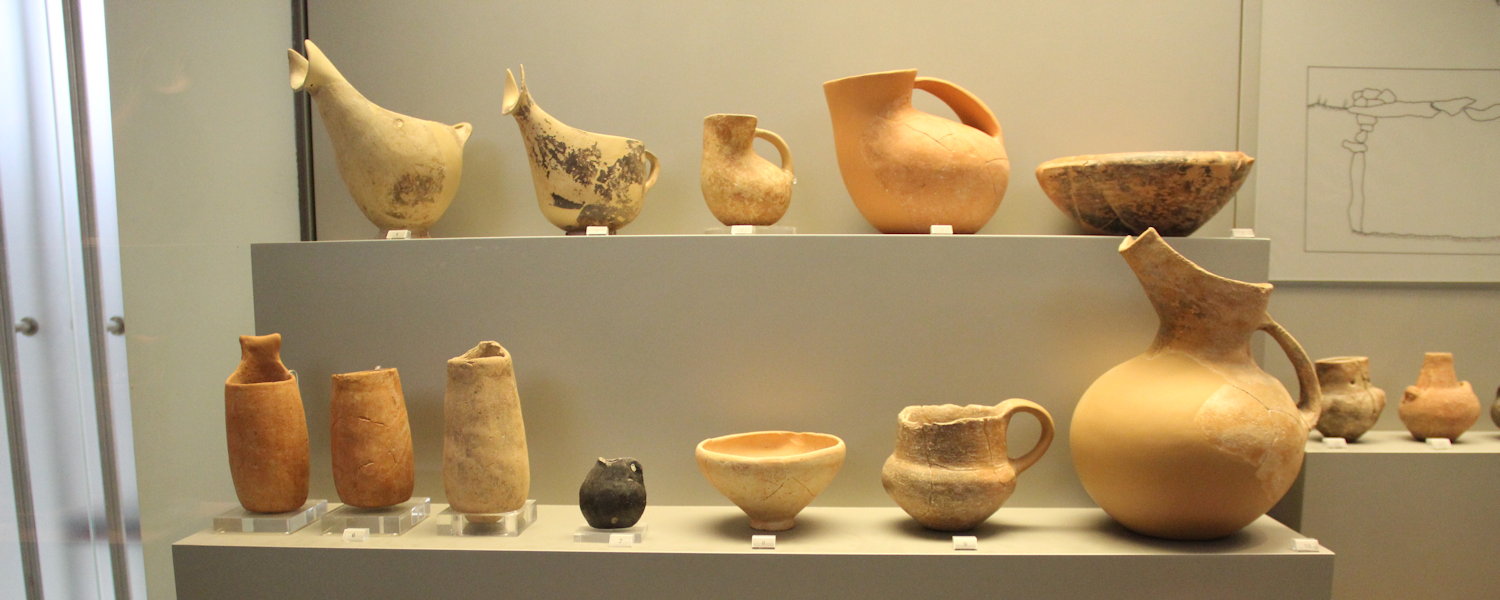6000 BCE-2600 BCE
The First Cretans
So far there have been no findings suggesting human habitation on Crete during the Palaeolithic or Mesolithic periods (I.e. before approx. 6500 BCE). The oldest evidence of humans on Crete is from the so called aceramic Neolithic period (6100 BCE – 5700 BCE).
Some wooden and stone tools, a bit of burnt seeds, jewelry and bones from domesticated animals were found in the lowest levels of the excavations at Knossos. Nobody knows where these people came from but Asia Minor or the Cycladic islands has been suggested. Recent discoveries (from 2011) suggests however that there may have been human visitors to Crete much earlier. (See below).
Life on Crete in the period
From the archaeological evidence it is known, that the first settlers introduced domestic animals to the island as well as domesticated cereals and legumes. These first inhabitants, therefore, did not seem to base their life exclusively on hunting, fishing and gathering but had some kind of agriculture. Otherwise virtually nothing is known about these the very first Cretans.
From the early Neolithic period (5700 BCE – 3700 BCE) finds are still sparse and restricted to Knossos only. These people constructed buildings of fired mud bricks with mud plastered walls. The pottery was initially crude and without decoration, later it was decorated with incised and dot-impressed motifs often filled with white or red paste. From this period we also have the first figurines made out of clay or stone.
The Archaeological Museum in Herakleion has one of the oldest – a female figure which perhaps is evidence of the worship of a 'mother goddess'. A cult that used to be widespread throughout the Mediterranean cultures. During the late Neolithic period there is evidence of trade between Crete and the Cyclades, Egypt and Asia Minor, from where copper, tin, ivory, and gold was imported.
Sights from the period in modern Crete
It is difficult to find visible traces from this early part of Cretan history in the landscape of Crete today. At The Archaeological Museum of Heraklion you can se some of the most important findings from 6.000 BCE to the pre-Palatial (Minoan) period, including clay sculptures, pottery and stone jars.
The Cave of Eileithya approx. 1 km south of Amnissos. Named after a mythological goddess, protector of pregnant women. The cave extends for over 64 meters. There is also a courtyard outside, which was probably used for ceremonial activities. The many objects uncovered prove its continuous use as a place of worship from the Neolithic period to the early Christian era. (Visits must be arranged with the guard at Nirou Chani).
Magassa (at the village Vrisidi). A Neolithic settlement on the eastern part of Crete. Many traces of Neolithic occupation have been found, such as stone axes, obsidian blades, a millstone and bone pins. The limits of a Neolithic house with an outer reception room and a large inner room for sleeping and everyday living can be seen.
Evidence of 130.000 year old sea voyage found in Crete.
(Excerpt from The Megalithic Portal. Saturday, 8. January 2011).
Archaeologists have uncovered evidence showing that early humans navigated across open waters thousands of years earlier than previously believed. According to the Greek Culture Ministry, archaeological experts from Greece and the United States discovered rough axes and other tools believed to be between 130.000 and 700.000 years old during a survey of the caves and rock shelters located in the areas of Plakias and Preveli.
The discovery is called "the most ancient sign of early navigation worldwide." The tools that have been discovered were described to be simple hand tools that were made out of stone. Archaeologists found a similarity between these tools and those associated to the Homo heidelbergensis (also referred to as the Heidelberg Man) and Homo erectus, early ancestors of modern humans that lived in Africa 200,000 years ago.
"Up to now, we had no proof of Early Stone Age presence on Crete", Maria Vlazaki- Senior Ministry Archaeologist- told the Associated Press, referring to the conclusive evidence previously found on the island that humans settled and inhabited Crete no earlier than the Neolithic Period. Crete became an island when it broke off from mainland Greece about five million years ago. The fact that Crete was already an island during this time, the ministry stated that the tools are "the earliest evidence in the world of ancient seafaring."
Before the discovery of the stone tools, the earliest evidence of open-sea travel in Greece was dated to be 11.000 years ago. "The findings not only prove marine travel in the Mediterranean existed tens of thousands of years prior to what was known until today," the ministry said in a report published by the AFP. "They also change calculations about early man's cognitive abilities."
Vlazaki pointed out that it is unclear where the hominids that created these tools sailed from, or whether they permanently settled on the island after arriving. "They may have come from Africa or from the east," she said. "Future study should help." The team of archaeologists that made the discovery has already applied for a permission to conduct further and more thorough excavations of the area. Greek authorities are expected to grant their approval on the request later in the year.

